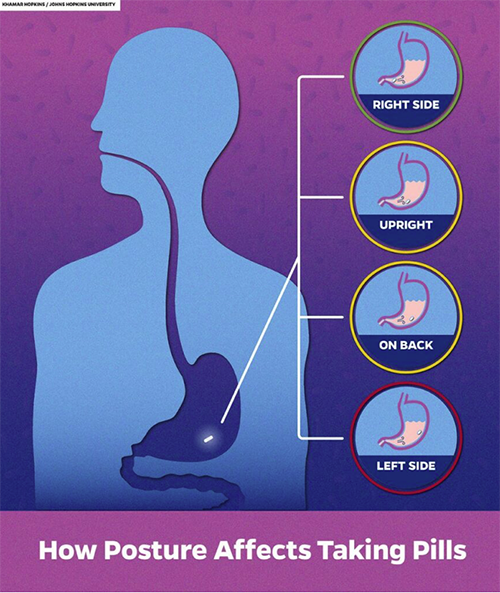“We were very surprised that posture had such an immense effect on the dissolution rate of a pill.”
– senior author Rajat Mittal, Johns Hopkins
Based on a novel mechanical model called a stomach sim, complete with mathematical equations and interpolated with principles of fluid mechanics, biomechanics, and physics, a Johns Hopkins press release  reports on a new study:
reports on a new study:
“A new … study finds your posture can make a big difference—as much as an hour longer—in how fast your body absorbs the medicine.”
More specifically, multiple press reports inform us that:
“leaning to the right side at a roughly 45-degree angle can halve the time it takes for a pill to dissolve compared to an upright posture. Conversely, lying on the left side is the worst possible posture, causing pills to take as much as five times more time (over an hour and a half) to dissolve than in an upright posture.”
The lowest point of the stomach is the antrum, next to the pylorus, the connection between the stomach and the duodenum. The difference in time-to-effect is attributed to the “transit time” for the pill to enter the stomach, dissolve, and reach the duodenum, where absorption begins. Thus, a pill landing in the stomach’s lowest part dissolves faster and empties its contents more quickly through the pylorus into the duodenum. The pill’s initial “landing zone” determines transit time.
The reports recommend taking the pill lying down at 45 degrees on the right side.
“Researchers tested four of the most common postures: standing completely upright, leaning or lying at a 45-degree angle to the right, leaning or lying at a 45-degree angle to the left, or lying flat on the back. … it takes a pill 10 minutes to dissolve on the right side, on average, compared to 23 minutes to dissolve in an upright posture. However, it took over 100 minutes for the pill to dissolve when lying on the left side. Lying straight on the back was tied in absorption time with standing upright.”
So next time you need to take an antihistamine for that runny nose or allergy – just lie down on your right side. Right? Not so fast. There are some serious difficulties with the study – one being that it didn’t discuss allergy pills, or indeed any other pill, except aspirin.
Imagine the difficulty of someone with Parkinson’s disease trying to take an L-Dopa pill lying on her right side at a 45-degree angle. I have a hard time imagining anyone swallowing a pill lying on their side midway between flat and upright.
And that’s because the study didn’t test the practice of the procedure. Remember the Alka-Selzer commercial with the man discoursing with his stomach sitting opposite him on a chair? That’s sort of what happened here.
People were not involved – only a disembodied “stomach model.” In this “out-of-body experiment,” the stomach-pylorus-duodenum model was reoriented in space to simulate differences in body posture and gravitational effects– which would occur only after the pill has been swallowed, disregarding the involvement of mouth, pharynx, and esophageal transport. Only when the pill hit the model stomach in its varying orientation were the measurements recorded.

Benefiting the disabled?
The authors tout the benefits of the study as particularly relevant for conditions associated with alterations of the anatomy and physiology of the stomach, such as gastroparesis, which is
“a long-term (chronic) condition where the stomach cannot empty in the normal way. Food passes through the stomach slower than usual”.
The concern arises in diabetes, Parkinson’s disease, collagen vascular disorders, and after certain (bariatric) gastric bypass operations, the first two diseases being significantly associated with aging.
“For elderly, sedentary, or bedridden people, whether they’re turning to left or to the right can have a huge impact”
- R. Mittal, Ph.D.
Too bad the practical world doesn’t work like a model and a bunch of equations. Recent studies show that 40% of the population has problems swallowing pills - even if standing or sitting erect. Some 18 million people suffer a condition known as dysphagia which includes difficulty swallowing any food or liquids, let alone medication. (The solution offered by researchers investigating dysphagia who were working on real people- is the rapid disintegration of tablets in the mouth before it gets to the pharynx, totally obviating the fluid dynamics model discussed by the fluid-physicists here). And, of course, the elderly person who has difficulty moving might find it difficult to lie on her side and swallow a pill while rotated at a 45-degree angle.
A Study with Too Many Limitations
Now, consider whether the results are even generalizable to this elderly, bedridden cohort, even if they can swallow at the “optimal” diagonal position without choking.
The results in this fluid-dynamics model incorporate the critical effects of gastric motility and food matrix on liquid content mixing, and the impact of stomach acid, including the breakdown of the swallowed pill in the gastric mix. However, the computational model was based on the anatomy of a 34-year-old adult male (named “Duke,” by the way). Remember, age and disease change stomach anatomy, along with the subsequent trajectory of swallowing, so one questions whether the findings are generalizable, let’s say, to bedridden or elderly patients. A couple of other unacknowledged limitations in the study:. It tested only aspirin, but what form? Gel or capsule, round or oblong, coated or not? Whether the high acid content of the aspirin affected dissolution – compared to, let’s say, an ant-acid tablet - is also not addressed.
Perhaps the most curious limitation – given the one-hour difference in results projected is the disclaimer:
“The current simulations are limited to modeling a short duration of the dissolution process (about three minutes), which is quite short given that drug dissolution might occur over many hours.”
A Solution in Search of a Disease?
Given the study, I thought I might try swallowing my Advil PM upright and then immediately lying on my right side. Not a good idea. Got a bad case of colic – burp gas and heartburn. It seems intestinal gas transmission is fastest in the upright position and upright positioning is the best way to relieve that condition Lying on the right only delays resolution. Sleeping on the left side is also recommended for good gut health. Among other reasons, that position of the stomach reduces acid reflux. So, I turned over and slept on my left side, and an hour later was still tossing and turning; less burp gas, though. I should have taken the pill upright or standing, as I usually do.
Incidentally, the ancient Greeks and Romans all ate reclining on their left– ostensibly to aid digestion.
Source: Computational modeling of drug dissolution in the human stomach: Effects of posture and gastroparesis on drug bioavailability Physics of Fluids DOI: 10.1063/5.0096877





